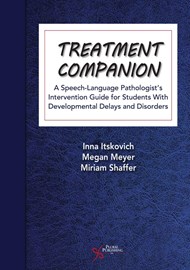Written by experienced speech-language pathologists (SLTs) and described as a speech-language pathologist’s best friend, the Treatment Companion serves as a therapy guide for SLTs working with children and young people who have communication delays and/or disorders.
The book is aimed at colleagues who are new to the profession as well as experienced SLTs. It not only contains a guide to gathering case histories, carrying out assessments, target setting and writing session plans but also provides a wide range of therapy ideas and strategies which would be useful for experienced therapists looking for fresh ideas.
Serving as a reference resource based on up-to-date evidence, the book outlines goals based on a developmental hierarchy, making it easy to dip in and out of with specific children in mind rather than reading it from cover to cover. It includes strategies for teaching a wide range of skills from developing a basic five-word vocabulary to more complex sentence structures and figurative language.
The Companion provides useful information addressing factors which affect treatment such as echolalia, physical disabilities, augmentative and alternative communication (AAC) and bilingualism. Under this section, there is some very basic advice for working with deaf children. It was encouraging to see that, as part of this advice, the authors have highlighted language deprivation as an area which should be targeted at an early stage by the introduction of sign language during the critical period for language acquisition. While this book is not specifically aimed at SLTs working with deaf children, it serves as a useful tool for therapists who possess the knowledge to adapt strategies for this client group.
This is an exceptionally detailed therapy manual and, as such, would be an essential addition to an academic or speech therapy service’s library.




